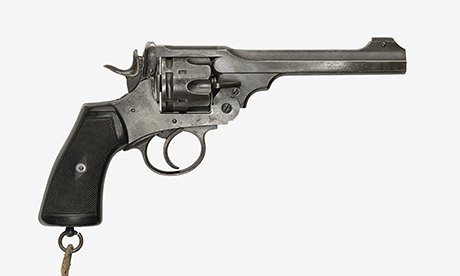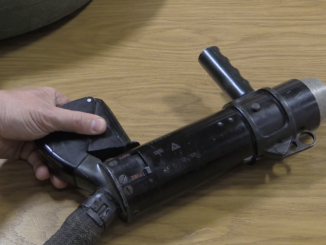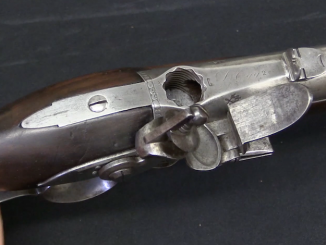So, I may have gone a bit overboard and filmed more video at this upcoming Julia auction than I actually had time to publish before the auction takes place (but there were so many amazing guns there!). One way I am going to cheat my way out of the dilemma is to post two videos today. They are both on fantastically rare Webley & Scott automatic pistols, so I figure they will go together pretty well.
First up, a Model 1904. This was basically the first working automatic pistol made by Webley (there was a 1903 toolroom experiment, but it didn’t really work). Like all the Webley automatic that would follow, it was designed by William Whiting. The 1904 was the company’s first effort at making a semiautomatic sidearm for the British military, so it was chambered for the .455 cartridge (a special rimless version made by Kynoch, after early experiments using the .455 rimmed revolver ammunition caused lots of problems stacking in magazines). It is a rather huge handgun, and uses a short recoil mechanism with two separate locking blocks. This particular one is s/n 23 – very few were made before it was rejected in military trials and Webley redirected its efforts toward smaller commercial pistols. I don’t know if I will ever have another chance to handle one of these, so I tried to make the most of the opportunity:
Webley came back to the military-style pistol a few years later, and the Model 1910 was a bit more successful – nearly a thousand of these were made. By the 1910 version Whiting had refined the locking mechanism to the angled lugs on the barrel that would remain in use through the Royal Navy contact in 1912/1913. This particular one, though, is a prototype with a number of unique features – most notably the lack of a grip safety.




Given the ‘rugged elegance’ of a Webley revolver, I’ve never gotten why their semi-auto’s are so hideous looking, that said the machining is absolutely gorgeous, surprised to see a gun I like the internals more than the exterior. And looks pretty strong, from what I can tell it comes second on the ‘pistols you could beat someone to death with’ list (first being the Steyr 1912.
In fact, we should always remember that we consider Browning-style automatic pistol as a “normal”. If something go another way in history and the Webley style become dominant, we would consider today a Browning-style handgun as a oddity.
“(a special rimless version made by Kynoch, after early experiments using the .455 rimmed revolver ammunition caused lots of problems stacking in magazines)”
Wasn’t that cartridge semi-rimmed rather than rimless?
“It is a rather huge handgun”
I assume it is caused by cartridge type used.
To be honest I prefer most designs over the look of a standard Browning design, but that’s mostly aesthetics. I understand the purpose behind Webley’s design, there’s just something really off putting and uncomfortable looking about the squared off look with a straight grip, that said if the design works then that’s the main thing as functionality has a beauty all of its own.
please, go overboard every day. 30 to 50.000 dollar is out of my league anyway, so this is as close i will ever get to a Webley. not a pretty pistol, but it has some very ingenious features. well done mr Whiting.
Some information about Webley-Scott automatic pistol from “В.Е. Маркевич Ручное огнестрельное оружие”:
Cartridge: 11.45mm caliber, bullet mass: 14.3g (~222gr), powder charge: 0.45g, muzzle velocity: 360m/s
Length of pistol: 216mm, mass: 1120g
Magazine capacity: 7
The Webley-Scott was good-balanced weapon (the center-of-mass was inside grip), superior in this area to Colt, Browning and Borchardt-Luger pistols. Later the slightly more powerful cartridge was developed (giving 52 kg*m of energy).
Drawback:
The grip-safety was unnecessary – it make construction more complicated and allow dirt to go inside
grip was too broad, the grip plates were made from Ebonite which tend to break when the pistol fall and hit hard surface.
These drawback were easy to remove.
W-S Model 1904,at contrast of common practice, carries the locking piece in front of the slide, therefore, reciprocally travelling at every shot. This construction grants an easiness of elevating that locking block via suitable cams provided both on receiver and barrel. It needs no seperate delocker. So called second lock is for retaining the barrel at recoiled back situation to wait the perfect joint
with forwarding slide. Very similar locking action was used by William Korth on his expensive pistols in the last half of past century. This pistol uses an escaping disconnector which solely seperates the trigger/sear engagement once with every trigger pull.
Model 1910 is interesting as the first user of ejection port/ barrel engagement on elevating type barrel locks. The pistol uses a hidden hammer and the screw head looking at back of the slide is the plug of manufacturing hole through which the drilling bit crosses and firing pin passes for dismounting in turn.
Like a P38’ish…
P38 has its locking block under the rear section of barrel. Conversely, M1904 WS contains the same piece in front section of its respectable slide. Further, P38 carries a seperate delocker pin in front of its double sided locking block, whereas the M1904 has none. The locking nature of M1904 heavily follows Cz52 in which, at delocking stage, slide and barrel velocities being not same. As mentioned in my first post, German Willi Korth’s expensive and huge atuoloading pistol is a dublication of Whiting’s M1904 locking system.
Regarding to M1910, it is the forerunner of.455″ 1913 Pistol and locking way is quite different. It is also the first of today’s simplified barrel/slide lock through ejection port being not in “Tilted barrel” but in “Elevated” form. Second user of this action is a prototype pistol patented in Poland in 1930 and archieved as Radom VZ30 but belonged to “Nouri Pasha” with sole example demonstrating in Military Museum of Harbiye/Istanbul. First large production sample of same lock engagement in well known Browning tilted barrel form is the French MAS M35S.
Webley-Scott Designer William John Whiting’s nearly all autoloader pistols have their recoil springs mounted at side of the handle receiver, leaf kind “V” spring under one side of the handle plate which possibly subject to breakage and if it occurs at instant of firing, lets think what happens to the shooter’s hand. However, Whiting’s one striker firing model has its coil type return spring mounted in the slide.
Does it disassemble like a Cz52 perhaps? “I thought it might, but you’d know”
Model 1904 dismounts via lowering the slide retaining bolt on which “Second Lock” engages and limits forward travel of slide. Cz52 contains same process in different construction, throuh a dismount bolt actuated by side wings in front of triger guard.
However, all pistols having their slides dismounted as drawing forwardly through frame guides, have same way; an arrester movable block in front of path of forward travel of slide in dismounting.
Correction; VZ30 should be Wz30.
Never heard of them I will have a look he he.
http://pubserv.uprp.pl/PublicationServer/generuj_dokument.php?plik=PL_000000000011813_B1_PDF
Interesting pictures, the Polish is somewhat Greek to me however but cheers.
A smaller caliber Webley Auto was used in the 1966 film adaptation of Farenheit 451, it is the gun that Captain Beatty draws, and loads, just before being immolated by Montag. I suppose the director wanted a new but old, utilitarian looking side arm, and the gun does have that look.
I really like it, it’s mechanical features – Hold open/auto mag release etc, the dropping barrel and I think it’s quite bonnie personally. Somewhat clunky, but there is beauty in objects possessing a certain industrial aesthetic so to speak.
That 1904 model is interesting, in that it shows Mr Whiting’s first attempt was kind of “ancient” well it fits into the category of an “early” design i.e. These contraptions were fairly new, so they were experimental by definition but they soon became fairly modern. Kind of like WW1 cavalry, there at the start but the war caught up with the times and they weren’t really representative of the zeitgeist of the age – Machines.
Well… Suppose I mean it’s kind of a c96 so “old” but with a magazine in the pistol grip. But, later it became a modern pistol, using a slide as a slide rather than as a bolt initiator – Thus allowing the pistol to become smaller.
The safety lever on the Model 1910 is actually unique to the models without the grip safety. I have one of the grip safety models and it’s the only safety on the gun. The slide release lever on that model is the same as the .455 1913 model / Mk.I N, and is pushed down to release the slide. Great little gun, I like it a lot – I agree it handles quite well, espescially compared to the .455. I read once, though I don’t know if it’s true, that Douglas Haig carried one.